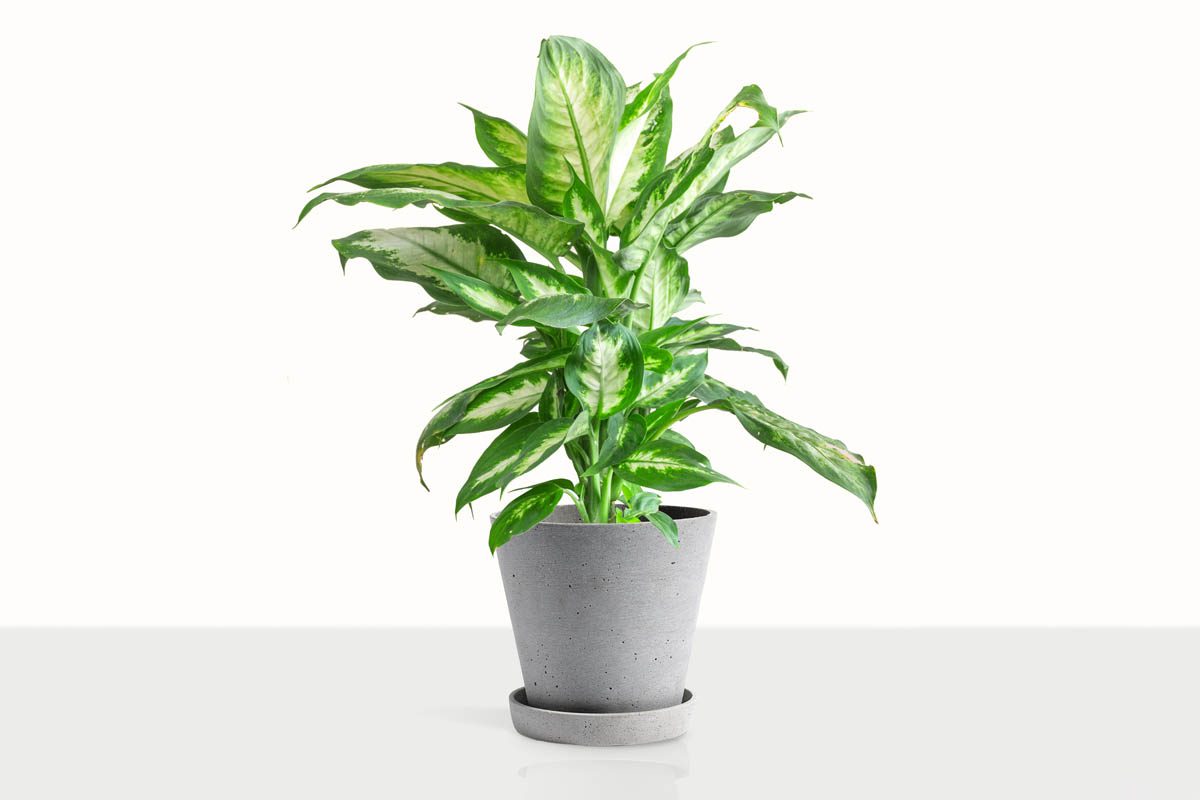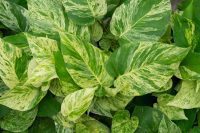Dieffenbachia is toxic to dogs. The toxic principles are proteolytic enzyme and insoluble calcium oxalate crystals known as raphides. Raphides are held in specialised cells called idioblasts, and when a dog chews Dieffenbachia, they penetrate the oral mucosa, triggering the release of histamine by the white blood cells. Damage to the oral mucosa allows proteolytic enzymes to penetrate the tissue, which increases pain and inflammation.
The reaction to Dieffenbachia is classed as mechanical irritant contact dermatitis, due to the physical injury. The immediate pain and irritation usually stops the dog from consuming too much Dieffenbachia, avoiding damage to the gastrointestinal tract.
What is Dieffenbachia?
| Family | Araceae |
| Botanical name | Dieffenbachia spp. |
| Common names | Dumb cane, Dieffenbachia, Tuftroot |
| Plant type | Perennial |
| Flower colour | White |
| Native to | South America, the Caribbean |
| Toxic properties | Insoluble calcium oxalate crystals, proteolytic enzyme |
| Toxic parts | All parts |
| Severity | Mild to moderate |
Dieffenbachia is a popular houseplant grown for its stunning variegated leaves and ease of care. The ovate leaves grow in a variety of interesting patterns of green and cream or white. Indoor Dieffenbachia typically grows to a height of 150 metres (5 feet).
The common name dumb cane was coined because when ingested, it can render a person speechless. Dieffenbachia was used by slave owners to torture slaves in Caribbean plantations¹. Due to the derogatory nature of the history of its use on slaves, as well as being ableist, people are encouraged to use the scientific name Dieffenbachia (pronounced ‘dee-fun-bark-ea‘).
Popular cultivars
- Dieffenbachia ‘Camille’
- Dieffenbachia ‘Camouflage’
- Dieffenbachia ‘Compacta’
- Dieffenbachia ‘Mariana’
- Dieffenbachia ‘Delilah’
- Dieffenbachia maculata ‘Tropical tiki’
- Dieffenbachia maculata ‘Camille’
- Dieffenbachia maculata ‘Exotica’
- Dieffenbachia ‘Honeydew’
Clinical signs of Dieffenbachia ingestion
Symptoms are quick to develop and may include:
- Intense pain and burning of the mouth, lips and tongue
- Oropharyngeal inflammation
- Pawing at the mouth
- Drooling
- Loss of appetite
- Vomiting
- Diarrhea
- Difficulty swallowing
- Respiratory distress (uncommon)
First aid
Carefully remove any remaining plant matter from the mouth and offer the dog a drink of something tasty such as tuna juice, milk or liquid stock (onion and garlic free). Contact your dog’s veterinarian or pet poison helpline for further advice.
In most cases, a wait-and-see approach will be recommended and you will be advised to bring the dog in if it experiences any symptoms such as vomiting or severe swelling. If the dog is experiencing difficulty breathing, immediate veterinary treatment is critical.
Treatment
There is no antidote to Dieffenbachia toxicity, and treatment is aimed at relieving symptoms. This may include intravenous fluids to prevent or treat dehydration due to vomiting and diarrhea. If the dog is experiencing difficulty breathing, the veterinarian will provide oxygen either in an oxygen tent or flow by. Extreme swelling of the throat will require intubation.
Prevention
The only way to prevent toxicity is to avoid having Dieffenbachia in the home or placing it in an area the dog can’t access such as a hanging pot. However, there is one reported fatality in a nine-year-old poodle following dieffenbachia ingestion². Thankfully most cases of Dieffenbachia ingestion are mild and self-limiting, but there is the potential for respiratory distress if the throat swells. Therefore, it is not recommended homes with dogs keep Dieffenbachia. There are plenty of pet-friendly alternatives for the green thumb.
REFERENCES
- Dumb Cane Plant. (2022). Ndsu.edu.
- Loretti, A. P., da Silva Ilha, M. R., & Ribeiro, R. E. S. (2003). Accidental fatal poisoning of a dog by Dieffenbachia picta (dumb cane). Veterinary and Human Toxicology, 45(5), 233–239.
Featured image: ANTHONY PAZ/Shutterstock
Julia is a writer and landscape consultant from Wollongong with a love of horticulture. She had been an avid gardener for over 30 years, collects rare variegated plants and is a home orchardist. Julia is passionate about learning and sharing her knowledge of plant propagation and plant toxicology. Whether it’s giving advice on landscape projects or sharing tips on growing, Julia enjoys helping people make their gardens flourish.




